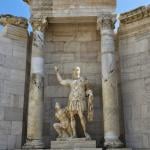 What are the big ideas at work in Greg Boyd’s monster volumes, The Crucifixion of the Warrior God?
What are the big ideas at work in Greg Boyd’s monster volumes, The Crucifixion of the Warrior God?
Boyd’s big ideas emerge from a singular moral problem in the pages of the Bible: the tension/contradiction between the warrior God of specific passages and the revelation of God himself in the cross of Christ. Thus, the cruciform God vs. the warrior God.
Boyd’s entire project is rooted in this being a problem; for those who don’t think this is a problem, there is no problem to resolve.
Boyd’s approach is to let the cruciform God interpret the warrior God. Hence, his approach is a species of theological interpretation of Scripture. The difference between Boyd and others is his theology not his method.
So, what are his big ideas? Which ideas do you think are sustainable and which unsustainable?
There are six of them:
First, When God acts in history the action is a mix of divine and human actions.
le saw that God “breathed” his supreme revelation on the cross by both acting toward us and by allowing others to act toward him. Because God honors the personhood of others, and because he therefore works by means of the influential power of the cross (l Cor 1:18) rather than by ultilizing coercive power, God’s “breathing” is a dialectical rather than a unilateral process.
We must therefore read this witness with the awareness that it reflects both God acting toward us, insofar as God’s people at the time could receive it, as well as God humbly allowing others to act toward him, insofar as the noncoercive heavenly missionary had to accommodate his people’s fallen and culturally conditioned hearts and minds.
Rather, it is only when we by faith look through the surface of this event that it becomes the definitive revelation of God for us, for only now can we discern the Creator stooping an infinite distance to become this guilty-appearing, godforsaken, crucified criminal. And it is this unfathomable condescension, which can only be perceived by faith, that constitutes the revelation of God in the crucified Christ.
Second, all actions ascribed to God in Scripture must be judged by the principle of cruciform accommodation.
In this light, the Principle of Cruciform Accommodation holds that the cross, rather than a presupposed philosophical conception of what perfect being” should be like, must serve as the primary criterion by which we access the degree to which any biblical portrait of God is and is not a divine accommodation. Hence, insofar as any divine portrait reflects the character of God revealed on the cross, it can be considered a direct revelation of God’s true character and will. But insofar as any divine portrait reflects a character that falls beneath what is revealed on the cross, it must be considered an accommodation that indirectly reveals God’s true character and will, for this revelation can only be discerned by those who exercise a surface-penetrating, cross-informed faith as they interpret it.
Third, all acts of divine judgment of humans are the result of redemptive withdrawal.
On the cross, Jesus stood in our place as a sinner and suffered the “wrath” that we deserved. And yet, to bring about this judgment, the Father did not need to become angry with Jesus or to act violently toward Jesus. Nor did he need to cause anyone else to act violently toward Jesus. To the contrary, we have seen that for Jesus to become our substitute, the Father merely needed to withdraw his protective presence, thereby delivering Jesus over to wicked people and fallen powers that were already “bent on destruction” (isa 51:13),
And this, I argued, warrants the conclusion that whenever God sees he must withdraw his protective presence to allow people to suffer the destructive consequences of their choices, he does so with a grieving heart and with redemptive rather than vengeful motives.
Fourth, in every act of God in the Bible we are to see the act as part of the reality of cosmic conflict at work in the world.
[The] NT understands Jesus’s crucifixion to be God’s decisive battle against, and victory over, the powers of darkness. As noted above, these powers were working behind the scenes when humans arrested, tortured, and crucified God’s Messiah. This, I argued, warrants the conclusion that we must read Scripture with the awareness that humans are not the only violent agents at work when God, with a grieving heart, sees he must withdraw his protection to allow rebels to come under judgment.
Fifth, God grants semiautonomous power to humans, and when God does, that agent bears responsibility for that action.
[T]he revelation of God on the cross depended on Jesus remaining perfectly obedient to the will of the Father.
I argued that these facts warrant the conclusion that whenever God grants a degree of divine power to human agents, they possess some degree of “say-so” over how this authority is used, just as they have ‘say-so” over how they use the free will that God has given them. And this, I further argued, is why God cannot be held responsible when servants he endows with extraordinary divine power end up using this power in destructive ways.
[SMcK: this needs to be connected to Romans 13:1-7.]
Sixth, the centralization of the cruciform God de-centralizes warrior themes and turns the agents of the cruciform God into agents of peace-making.
On the cross, Jesus exposed this sinful god-in-our-own-image to be the blasphemous lie that it is. On the cross, the diabolic violent warrior god we have all-too-frequently pledged allegiance to has been forever repudiated and “brought to nothing” (l Cor 2:6). Out of fidelity to Christ crucified and to our call to be peacemakers, and for the sake of a world that continues to perpetuate the same mindless cycle of violence that has imprisoned it since the Fall, it is imperative that Jesus-followers today renounce this warrior god once and for all and regard it to be the “nothing” that the cross made it to be.
If we fully trust the revelation of the crucified God, we can only understand his crucifixion to be the permanent crucifixion of the warrior god.












